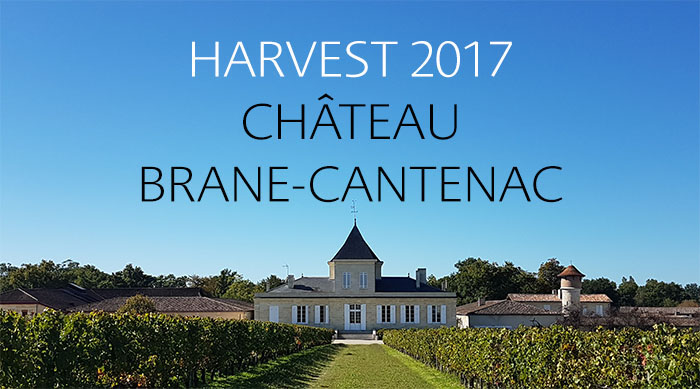 |
Ready Steady Margaux
Working in the wine trade and speaking to customers about drinking habits, you often hear the expression ‘everyone comes back to Bordeaux’. For me this was even more the case, as I headed down to the South-west of France for my second harvest period in the region. I’m not sure the Bordelais are going to keep warmly receiving me, as I’m certainly not bringing good weather with me. My last harvest in 2011 was characterised by damp conditions and not enough sun (pretty much London weather all year round) and 2017, by all accounts, has given winemakers similar issues to contend with.
Unfavourable conditions including a pretty cold summer means this won’t be a 2016 where everything came together perfectly at the last minute or a ‘vintage ending in 5 or 0’ where the Bordelais could pick the grapes in their own time and put their feet up. There is an excellent, thorough report on the conditions through the year by Gavin Quinney here but in short, there is good potential in 2017 however it will be a ‘winemakers vintage’ where those with a sharp mind and soft hand are able to produce something to get excited about
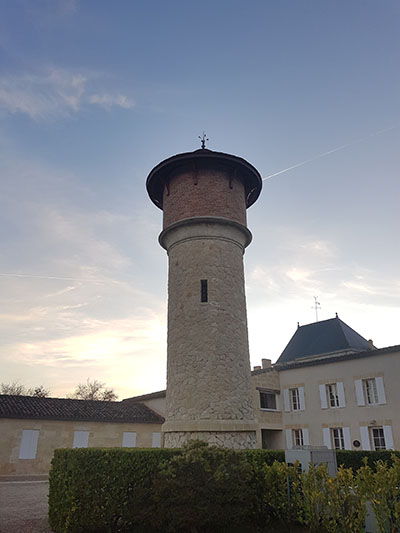
The water tower
|
Fortunately for me, I’d secured a picker/dogs body/pump-over helper position at 2nd growth Brane Cantenac, an ideal place to check the quality of both the Cabernet & Merlot. Neal Martin described the 2016 vintage here as ’a benchmark against which future vintages will be compared’ and it’s clear the quality (in respect of the vintage) here is increasing year-on-year. A great dinner with proprietor Henri Lurton & commercial director Marie-Helene Dussech on the recent en primeur trip included some fabulous back vintages but the 2016 was the real standout.
I arrived at the back-end of the harvest, with just small plots outside of the chateau left to pick and fermentation in tanks just starting. Pierre, the vineyard manager at Brane told us how these plots could prove tricky as they were the ones most affected by the frost which hit a couple of months ago. Brane Cantenac’s crowning jewel is without doubt the sloping plateau that sits in front of the chateau. A combination of excellent drainage and lush foliage and stones under the vines, which retain heat during the night, make the vineyard frost-proof.
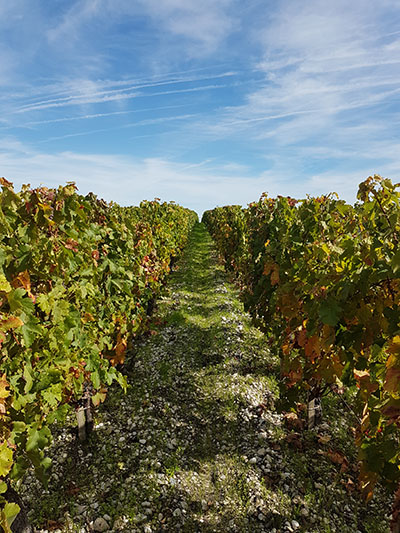
The Brane Cantenac plateau
|
The grapes we picked in the smaller plots were not too affected, a result of the meticulous work in the vineyard throughout the year. To guarantee quality, grapes are then sorted three times: first by hand in the vineyard; then on a sorting table at the chateau before a final check inside the optical sorting machine. This incredible invention works by allowing the winemaker to dictate exactly what shades of purple and what size of berry they want going into the tanks. Ten tonnes of berries per hour are checked and any berry that does not match that pre-specified size or colour is ejected from the table using a jet of air.
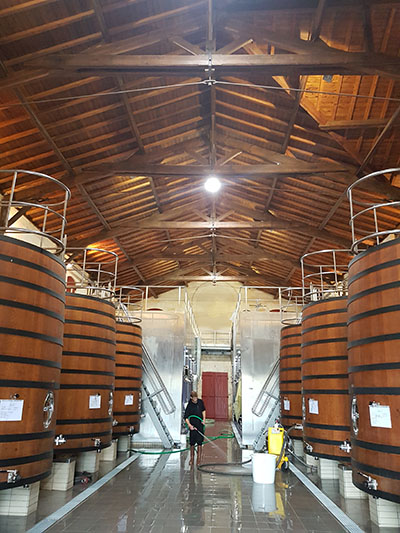
The old wooden cellar
|
Brane New
There are additional modern inventions in the winery where the focus seems to be on upgrading and improving the current infrastructure rather than wholesale changes or gargantuan new structures. This can be seen in the new cellar, attached to the old winery which contains eight brand new, beautiful temperature controlled wooden vats. Built by barrel-makers Seguin Moreau, the wood gives an additional roundness to the tannin and the addition of a window lets the winemaker keep a keener eye on the juice and cap inside. The room and vats blend in well with the rest of the chateau but also allow the use of (the increasingly popular) ‘gravity winemaking’ so no pumps are needed.
I spent a good part of the week in here helping with the ‘remontage’. This translates as ‘pumping over’- the process of passing the juice back over the skins and seeds (which form a cap), in order to extract tannin and flavour. Florent, the Cellar Master here who has done stints at wineries including Dominus in Napa Valley, tells me that pumping over using gravity allows ‘softer extraction’. This means flavour and aromas are taken from the skins less aggressively so creating finer and silkier tannins. Twice a day for one hour, the fresh Cabernet juice is dispensed from the bottom of the vat into a cylindrical container. This is lifted by forklift before being fanned evenly back over the cap.
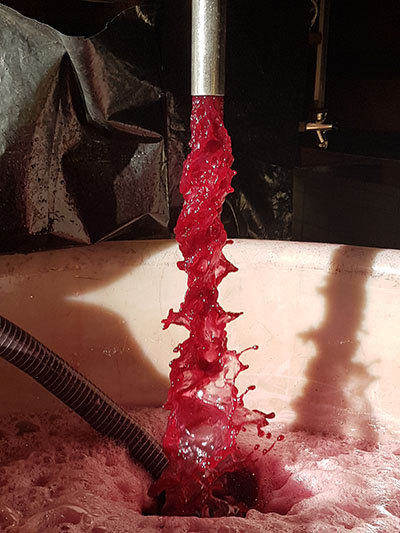
Pumping over with pumps..
|
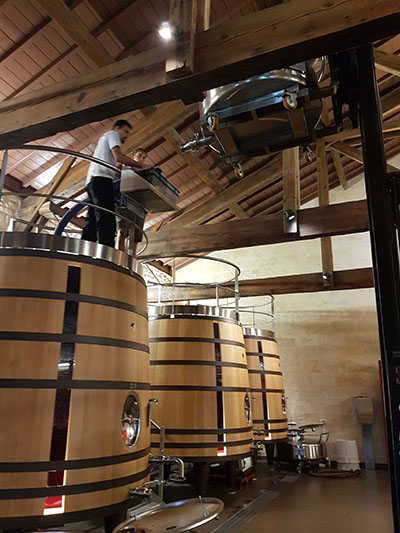
..and with gravity
|
Another technique used for extraction is ‘pigage’, the process of breaking the cap. This slightly heavier handed method uses two huge arms (think ‘The Claw’ from Toy Story) to push down the skins causing more contact between the cap and the juice. The device sits on top of the vat and the arms are moved around and then outwards. The trick is to break up the entire cap with the fewest presses so, again, the greatest amount of extraction with the least aggression. You can see why they are pleased with this new bit of kit, as it allows greater concentration in the wine without losing finesse.
Pigage is only used for the plots that are definitely going into the Grand Vin, such is the effort to make sure none of the wines are too overworked. The final winemaking technique which is used here is ‘delestage’- moving all the juice and skins from one vat to another. This has the advantage of speeding up fermentation (it often involves the juice meeting more oxygen) and greater contact between juice and skins as the cap reforms. Nonetheless, it is used sparingly here due to the focus on not overly extracted wines. It is refreshing to be working somewhere where the focus seems to be on terroir and quality of grapes rather than winemaking. Personally, it is what I look for in my claret, modern techniques but not trying to be something that it isn’t.
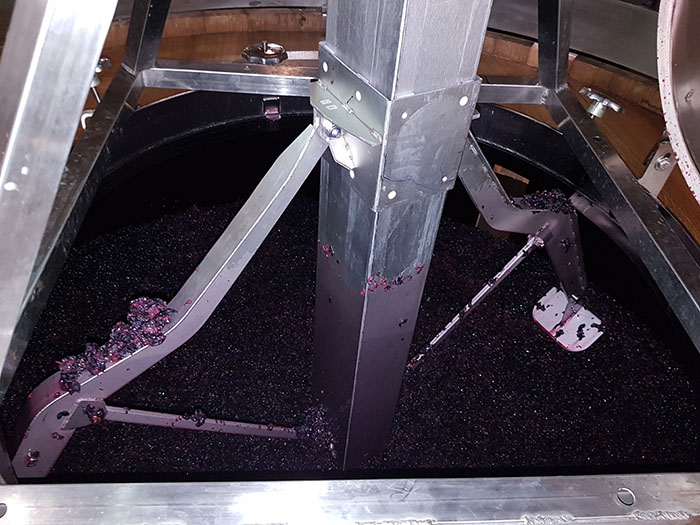
The pigeage machine
|
As well as Cabernet Sauvignon and Merlot, Brane Cantenac has plots of Cabernet Franc, Carmenere & Petit Verdot. I was helping with some experiments to see what characters these grapes exhibit when fermented on their own, in order to see what they can possibly add to the final blend. As there is not enough for a full tank, these parcels are fermented in barrel (burgundy style). As a result, the ‘remontage’ is done by hand. The barrels, which are sitting on rollers, receive twenty revolutions, twice a day. This provided a decent workout and an interesting insight into these lesser known varietals. The last two vintages of Brane have contained 1% Carmenere. When the vintage is warm enough and it is able to ripen, it gives the wine weight and some white pepper notes.

Rolling barrels to help the fermentation
|
It’s all in the blend
Towards the end of the week as fermentation in the Merlot tanks started to finish, attention turned to the cellar, moving the wine from tank to barrels and ‘decuvage’- removing the cap from the tanks. While I cracked on shovelling skins and seeds out of the vats (and trying not to breathe in too much CO2!), the team at Brane taste the plots, deciding which label they will go into- Grand Vin, Baron de Brane (2nd wine) or Margaux de Brane (3rd wine). They are helped by Eric Boissenot, the Medoc’s leading consultant winemaker. Frederic Engerer of Chateau Latour has described Eric (and his father Jacques) as ‘their value in optimising the selection of our lots in order to make the best possible ‘assemblage’ (blend) is very clear’. Marie-Helene says that not only is Eric able to help gauge the quality of different plots, but he has years of experience in which winemaking techniques will complement the vintage conditions and the style of wine the chateau is looking for.
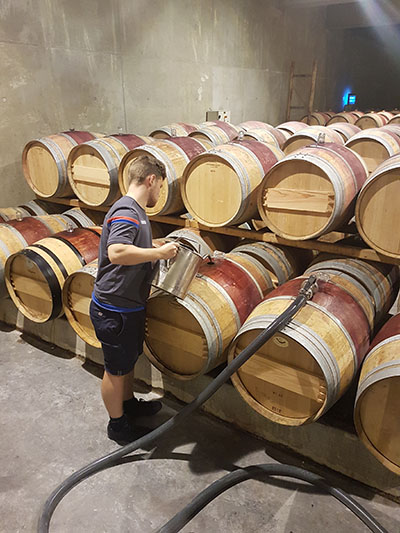
Ben Browett topping up barrels
|
Once quality is decided, the wine is moved into barrels which are predominantly medium and medium-light toast. Brane use a variety of different coopers including Radoux who famously give Tertre Roteboeuf its round, almost Burgundian perfume notes. Several afternoons were spent cleaning barrels ready to be filled and ‘topping up’ those that had been. Christophe, the estate manager, tells me how after the malolactic fermentation in barrel, the final blend is made before maturation. This is important in achieving the elegant style that Brane Cantenac desires as the ‘finished wine’ with all its parts in place, is able to mature and extract from the oak. The other strategy, adopted by some chateau, is to wait until the final moment before bottling to blend their wine. This allows more control over the style but less balance as different grapes have matured separately from each other.
There is an incredible attention to detail from the team in the cellar and the directors in the winery which is creating fantastic results. Christophe was formerly the cellar master here and has over 20 years at Brane Cantenac while Marie-Helene was formerly at Chateau Latour during John Kolasa’s tenure. The winery is the perfect mix of classic and modern but without being flashy. Lucien Lurton lives in the modest chateau next door which sits under the restored water tower, watching over the main plateau.
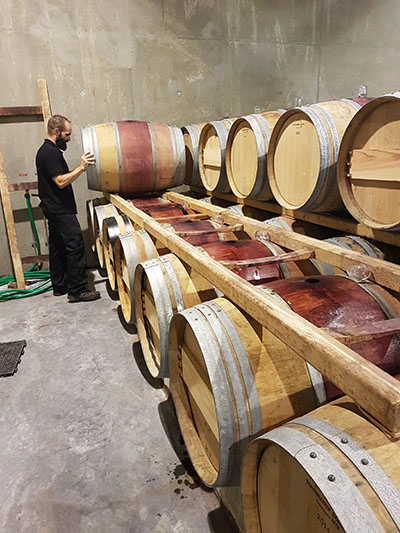
Florent the Cellar Master arranging barrels
|
It is clear that the terroir is excellent here hence why it is mentioned so regularly when speaking with Henri Lurton about what contributes to the style of Brane Cantenac, the phrase ‘terroir driven’ coming up several times. A high proportion of clay in the soil means almost Pomerol-like tannins with very few hard edges evident in the wine. Nowhere was this more obvious than the go-to lunchtime wine during my stay. Unsurprisingly, the lunch on offer was fantastic however the star of the show was without doubt, Baron de Brane 2010. This outstanding 2nd wine with its great concentration of fruit and those round, supple Brane tannins is definitely better than some classed growth wines in lesser vintages. It also has the benefit of being a 2010 that is ready to drink. I enjoyed it so much, I made sure Farr Vintners bought the rest of the available stock.
For more information click here.
A huge thanks to everyone at Brane Cantenac for an enjoyable and informative couple of weeks. We were looked after wonderfully and it was great to work with the fantastic cellar team and contribute (a little bit) to the vintage..

Bordeaux sun streaming through the vines
|